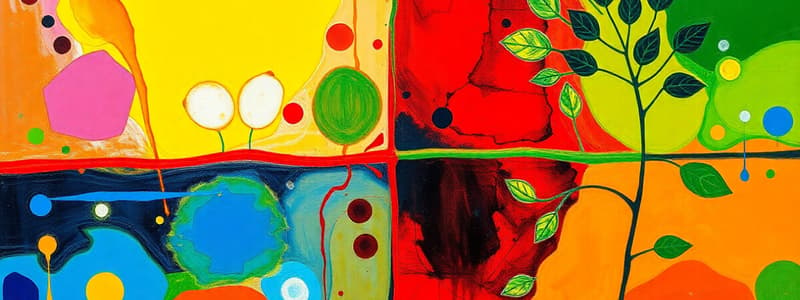Podcast
Questions and Answers
Which of the following is a reactant used during photosynthesis?
Which of the following is a reactant used during photosynthesis?
- Ethanol
- Oxygen (O₂)
- Glucose (C₆H₁₂O₆)
- Carbon dioxide (CO₂) (correct)
Which organelle is responsible for photosynthesis?
Which organelle is responsible for photosynthesis?
- Ribosome
- Chloroplast (correct)
- Mitochondrion
- Nucleus
What is the main product of the light-dependent reactions?
What is the main product of the light-dependent reactions?
- Oxygen (O₂) (correct)
- Water (H₂O)
- Carbon Dioxide (CO₂)
- Glucose (C₆H₁₂O₆)
What is regenerated during fermentation, allowing glycolysis to continue?
What is regenerated during fermentation, allowing glycolysis to continue?
What is produced during alcoholic fermentation?
What is produced during alcoholic fermentation?
What is energy of motion called?
What is energy of motion called?
What is a reaction that releases energy called?
What is a reaction that releases energy called?
What is the term for the sum of all chemical reactions in an organism?
What is the term for the sum of all chemical reactions in an organism?
Flashcards
Photosynthesis Reactants?
Photosynthesis Reactants?
CO₂, H₂O, and light energy.
Photosynthesis Products?
Photosynthesis Products?
Oxygen (O₂) and glucose (C₆H₁₂O₆).
What is a Chloroplast?
What is a Chloroplast?
The organelle responsible for photosynthesis.
Purpose of Fermentation?
Purpose of Fermentation?
Signup and view all the flashcards
What is Kinetic Energy?
What is Kinetic Energy?
Signup and view all the flashcards
What is Potential Energy?
What is Potential Energy?
Signup and view all the flashcards
What is an Exergonic Reaction?
What is an Exergonic Reaction?
Signup and view all the flashcards
What is Activation Energy?
What is Activation Energy?
Signup and view all the flashcards
Study Notes
- Study notes based on flashcard questions and answers are presented
Photosynthesis
- Reactants: Carbon dioxide (CO₂), water (H₂O), and light energy
- Products: Oxygen (O₂) and glucose (C₆H₁₂O₆)
- Chloroplasts are responsible
- Stroma refers to the space around the thylakoids
- Short wavelengths have the most energy
- Water (H₂O) is the source of released oxygen
- Colors are visible due to the reflection of certain light wavelengths
- The main product of light-dependent reactions is oxygen (O₂)
Calvin Cycle
- Carbon Fixation: RuBisCo attaches CO₂ to an organic molecule
- Reduction: ATP and NADPH convert molecules into G3P
- Regeneration: G3P is recycled into RuBP
- The final product is glucose (C₆H₁₂O₆)
- Carbon dioxide (CO₂) is required
Cellular Respiration & Fermentation
- Aerobic respiration generates ATP when oxygen is available
- Fermentation occurs when oxygen is not available
- The main purpose of fermentation is to regenerate NAD⁺ so glycolysis can continue
- Two types of fermentation: lactic acid fermentation and alcoholic fermentation
- Lactic acid and ATP are produced during lactic acid fermentation
- Ethanol, CO₂, and ATP are produced during alcoholic fermentation
- A facultative anaerobe can survive with or without oxygen
Energy & Metabolism
- Energy is the capacity to do work
- Kinetic energy is the energy of motion
- Potential energy is stored due to position or structure
- Chemical energy is potential energy stored in chemical bonds
- An exergonic reaction releases energy and occurs spontaneously
- An endergonic reaction absorbs energy and is non-spontaneous
- An anabolic reaction builds larger molecules from smaller ones, requiring energy
- A catabolic reaction breaks down molecules and releases energy
- Metabolism is the sum of all chemical reactions in an organism
- Activation energy is the minimum energy required to start a chemical reaction
- An enzyme is a protein that speeds up chemical reactions by lowering activation energy
- A substrate is the reactant that an enzyme acts upon
- The active site of an enzyme is the region where the substrate binds to the enzyme
- The first law of thermodynamics states that energy cannot be created or destroyed, only transferred or transformed
- The second law of thermodynamics states that every energy transfer increases entropy (disorder) in the universe
- ATP powers cellular work by releasing energy when a phosphate group is removed (ATP → ADP + Pi)
- Enzymes speed up reactions by lowering the activation energy
Studying That Suits You
Use AI to generate personalized quizzes and flashcards to suit your learning preferences.
Description
Study notes cover photosynthesis, the Calvin cycle, cellular respiration, and fermentation. Photosynthesis uses carbon dioxide, water, and energy to produce oxygen and glucose. The Calvin cycle uses carbon fixation, reduction, and regeneration to produce glucose. Aerobic respiration generates ATP in the presence of oxygen, while fermentation occurs without oxygen.




